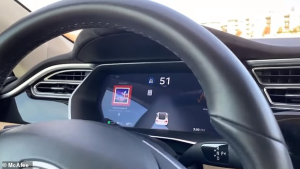Elon Musk may have convinced us that Tesla cars are the safest on the road, but recent findings suggest otherwise. Believe it or not, a simple piece of tape on a speed limit sign can trick Tesla’s new models into dangerously high speeds. Startling footage has emerged, showing a Tesla car accelerating from a speed limit of 35 miles per hour to an alarming 85 miles per hour, all due to the manipulation of a sign.
With Tesla’s stock prices soaring uncontrollably, the company has faced increased scrutiny lately. In response, McAfee researchers conducted an experiment where they placed a two-inch piece of electrical tape across the middle of the number “3” on a speed limit sign. Astonishingly, the manipulated sign tricked the Tesla car into misreading the speed limit as 85 miles per hour.

The specific model involved in this experiment was the Tesla Model X from 2016. While in cruise control mode, the vehicle heavily reliant on computers accelerated to 50 miles per hour before the driver realized the danger they were in. This revelation comes at a time when Tesla is already under investigation by the National Highway Safety Administration (NHTSA) for 127 complaints of “sudden unintended acceleration.”
Unfortunately, this flaw in Tesla’s technology has led to 110 crashes and 52 injuries. Tesla owners, who have invested significantly in their vehicles, have found themselves in perilous situations due to the car company’s oversight in ensuring driver safety while using cruise control.

The McAfee experiment demonstrates that even a tiny modification like electrical tape on a speed limit sign can pose a serious risk to the driver, even if the vehicle is not operating on autonomous mode.
McAfee stated, “By making a tiny sticker-based modification to our speed limit sign, we were able to cause a targeted misclassification of the MobilEye camera on a Tesla and use it to cause the vehicle to autonomously speed up to 85 miles per hour when reading a 35 miles per hour sign. For safety reasons, the video demonstration shows the speed start to spike and TACC accelerate on its way to 85, but given our test conditions, we apply the brakes well before it reaches target speed.”
Tesla, however, does not consider McAfee’s research as valid since it involved an intentional act to manipulate the computer camera. But should it be dismissed? Should Tesla take steps to manufacture its models in a way that prevents people from tricking the technology?
“The altered sign hardly looks suspicious or malicious, even to the trained eye, and many who saw it didn’t realize it had been tampered with at all,” argued McAfee.
What is your opinion on this matter?
Source: fadnews24.com


